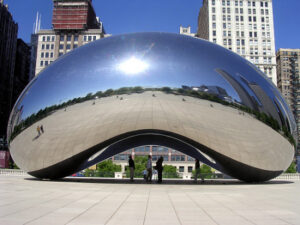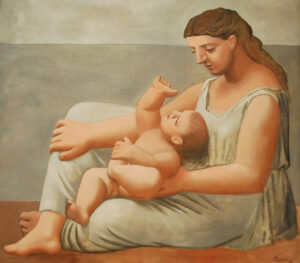By Brian Nixon

For those familiar with Chicago, you’d know that the city is full of magnificent visual art. From the Institute of Art to the Contemporary Museum of Art to sculptures spread throughout the city, Chicago is a hub for art lovers. Chicago is also the residence to the Poetry Foundation, the former home of noted architect, Frank Lloyd Wright, the childhood home of writer Ernest Hemingway, magnificent architecture, wonderful jazz clubs, and a thriving theatre scene. Art abounds in the Windy City.
On a recent trip to Chicago, my family and I took in some of the art found in this great metropolis. Our first stop was at the Institute of Art to see the exhibit, “Picasso and Chicago.” The exhibit is the largest collection of Picasso’s work gathered in the U.S. in one place in over thirty years. 250 paintings, sculptures, drawings, and watercolors graced the walls of this magnificent building. We arrived at the museum when it opened,

and left a half hour before it closed and didn’t begin to see the entire collection the museum had to offer.
We also checked out the Museum of Contemporary Art, viewing the exhibition entitled “Destroy the Picture: Painting in the Void,” featuring the fascinating art of British artist, John Latham (1921-2006) and others. Also at the MCA were musical manuscripts by noted American composer, John Cage (1912-1992).
Additionally, we were able to see the Frank Lloyd Write House, the Ernest Hemingway museum and childhood home, the Poetry Foundation headquarters, the Smith Museum of Stained Glass Windows, the Sadao Watanabe exhibit at Wheaton College, and listen to Jazz at Al’s Jazz Club. In short, we soaked in the art of Chicago.
So why all this talk about art? In a couple of words: art matters. And it matters on two different levels: theologically and anthropomorphically, or divinely and humanly.
Let’s tackle the theological elements of art first. It’s been said many times over that God is the Great Artist, the Master Creator. And it’s true.
But what exactly does this mean? Is God a beret-wearing, easel-carrying kindly gentleman painting all he can see? Of course not. But it does mean that inherent in God’s person and character is the essence of creativity; the very basis of imaginative and inspired acts-including formulation and spatiality; all artistic endeavors are manifest in God’s nature. I’m reaching here, but much like God is love, God can be seen as that which produces Art: the quintessence of revelation. God by his nature is ultimate Creativity. God and art are intertwined because God is equal to His nature.
The Lord states to Moses in Exodus, “I am that I am.” Here we find God stating that He is the center-the beginning-of all being, including beauty, inventiveness, goodness, etc. And part of God’s nature is to create. Therefore, God arouses and motivates creativity in the world, what I’ll call Theo-art, Eternal Art, and God-Art. He is not only the Great Artist, but also the object of our desire; the initiator of the process; and by His very nature defines for us beauty and creativity.
In the first chapter of the book of Genesis-where we first learn about God’s nature-we discover that He creates. Specifically, it reads: “In the beginning God created the heavens and earth.” As any Hebrew lexicon will tell you, the word for create is “bara.” Bara means to “shape, fashion, form, or create.” A few verses down, in verse 7, we see the word, “made.” The Hebrew word for “made” is “Asah.” “Asah” means to “do” or “make.”
With both words we find God actively creating; in the case of Genesis chapter one, all that is known in our universe. So it goes that from God’s creative self stems all creative activity. In a way, the two components, the creative and the act of creativity, are co-substantial, of one being.
With all this chatter it must be stated that God is not the same as His creation: Art/creation is not God. Rather, art/creation stems from God and reflects God, His fingerprints, if you will. Just as all love isn’t God, all creation or art isn’t God. But both love and art find their meaning and essence in God.
I could go on and on about all of this. I won’t. I hope the answer as to why art matters-theologically-is because art is directly related to God’s nature, character, and actions in the universe. God the artist and the art-essence of God are one in the same.
Now to the second reason why art matters: anthropomorphically, or humanly. Art matters to people because it relates to us as creative beings, documenting our existence on planet earth; allowing us to state philosophical and aesthetic claims; and fulfilling an unction to form components from our world in creative acts (of which, I believe, stems from the Imago Deo, the image of God weaved in our DNA).
Brethren/Quaker poet, William Stafford, in the book, “The Answer Are Inside the Mountains,” states “art will, if pursued for itself and not for adventitious reasons or by spurious ways, bring into sustained realization the self.” Or put another way, art helps us understand what it means to be human.
Later, in the same book, Stafford states, “Art is the heaven of experience.” If you were to combine these two statements, you could come up with a basic, working understanding of art operating in humanity: “Art-through our shared experience as humans-helps us realize our self, our place as individuals within the world and life.”
So if art matters theologically and anthropomorphically, is there such thing as Christian art?
Yes, and no.
Noted theologian, R.C. Sproul states it as follows: “What makes art Christian art? Is it simply Christian artists painting biblical subjects like Jeremiah? Or, by attaching a halo, does that suddenly make something Christian art? Must the artist’s subject be religious to be Christian? I don’t think so. There is a certain sense in which art is its own justification. If art is good art, if it is true art, if it is beautiful art, then it is bearing witness to the Author of the good, the true, and the beautiful.”
So, yes, there is Christian art when art is done with truthfulness, beauty, goodness, and the like: art that reflects the attributes of the Creator.
And, no. There isn’t ‘Christian art’ in that art can’t be filled with the Holy Sprit like a human can. Art can be inspired by the Holy Spirit through a person creating the art, but art can’t be ‘saved’ as a desk can’t be ‘saved.’ For what makes someone Christian-Biblically speaking-is the indwelling of God within that person: non-animate object fall outside this understanding.
But both art and a desk are products of an eternal network of God’s image working within His creation, producing, fashioning, forming, and shaping the objects-with the stamp of His nature; but not inhabiting a non-human object in a real sense.
To this extent, art is neutral; much like a desk or a table is neutral. However, how art is used has moral implications. The subject-and understanding-of art can be Christian or non-Christian in orientation, but this discussion is for another article.
If there is not “Christian” art per say, is there a divine aspect to art? I think the above discussion makes the case that there is, which leads back to Stafford: “Art has its sacramental aspect. The source of art’s central effect is one with religion’s and those of other soul endeavors: the discovery of the essential self and the cultivation of its felt, positive impulses.”
I like that: “a sacramental aspect.” A sacrament is something that is done with a significant, spiritual meaning, giving due honor to the object, be it God or otherwise. In this case, art is a sacrament-not in the traditional Christian definition (baptism communion, etc.)-but in the understanding of giving to God what He has ultimately inspired and brought forth; offering art as a sacrament, a gift to bring God honor.
A way to think through the sacramental aspect of art takes us back to Chicago. Sitting in Millennium Park-just North of the Art Institute-is a very popular sculpture entitled, Cloud Gate, made by British artist, Anish Kapoor. Cloud Gate (dedicated on May 15, 2006) is affectionately known as “The Bean.”
Cloud Gate is a large metallic sculpture that reflects the cityscape and people who walk up to it. It is shaped in a bean-like form, covered in stainless steel. It’s common to see hundreds of people surrounding “The Bean” snapping photos of the sculpture, but while taking picture of Cloud Gate, they are also capturing the city and themselves in the reflection of the statue. Cloud Gate allows the viewer and the surrounding area to be a part of the art. In this case, the nature of the Cloud Gate extends beyond itself.
Cloud Gate is much like the sacramental aspects of art. Though the people or the cityscape of Chicago reflected in Cloud Gate are not Cloud Gate themselves (part of the metallic makeup of the sculpture), they are in a way part of the art, a reflection found on-and in-Cloud Gate. They are intertwined; co-substantial, and weaved into the larger narrative of what Cloud Gate represents. When people approach Cloud Gate, they give of themselves by being included in the art.
Cloud Gate is also a helpful analogy highlighting God’s influence within the artistic process. All art is a reflection of God’s creative nature; God is the originator of art. And because of His creative nature, God allows the reflection of His nature to proceed from Himself, akin to the reflections from Cloud Gate. This reflection affects and influences those that stand within His presence (all humanity). In turn, people are found inhabited and influenced by God’s nature through common grace (grace that is common to humankind), becoming partakers in God’s divine artistic language. And this divine-human interaction has sacramental components-the offering of the art through a creative process, reflecting the nature of God on Earth.
And because of this sacramental-divine-human interaction: art matters.




Like the reflection on art as something that IS – something inside of us that God pulls out as part of the creative experience of experiencing what it means to be human – trying to “get out” or, as you put it, “see ourselves as part of the larger landscape” that is entirely made by and for God’s glory – so that art that reflects that back to us is a way to get closer to God and might be called “Christian art,” and art that turns us away from all he has made (and is making) might be called otherwise. Either way, love the thoughts on the nature (and reasons) for the wonderful gift we call ART. – daynawrites.blogspot.com
Comments are closed.